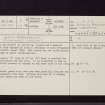Dernaglar Loch
Crannog (Period Unassigned), Logboat (Period Unassigned)
Site Name Dernaglar Loch
Classification Crannog (Period Unassigned), Logboat (Period Unassigned)
Alternative Name(s) Loch Dernaglaur; Loch Dernaglar
Canmore ID 62143
Site Number NX25NE 6
NGR NX 264 581
NGR Description NX c. 263 581
Datum OSGB36 - NGR
Permalink http://canmore.org.uk/site/62143
- Council Dumfries And Galloway
- Parish Old Luce
- Former Region Dumfries And Galloway
- Former District Wigtown
- Former County Wigtownshire
NX25NE 6 c. 263 581
(Area NX 264 581). An artificial island and a dug-out canoe were exposed by partial drainage of Loch Dernaglaur (NX 264 581) about 1855. The island was not sufficiently exposed to admit investigation.
The canoe, 11' long by 31" by 11 1/2" deep is grooved for a stern-board and has ribs. It is preserved in mud in a natural harbour of stones on the east side of the loch.
R Munro 1885.
In recent years this loch has been partially drained and subsequently refilled. Nothing was seen of a crannog nor was there any sign of the canoe.
Visited by OS (JP) 15 June 1976.
(Location amended to NX c. 263 581). In 1885 Munro examined a 'single-tree dug-out' which had earlier been discovered during drainage operations around the margins of Loch Dernaglar (or Dernaglaur). This loch is situated in rough pasture among drumlins and at an altitude of about 90m OD. A crannog was revealed at the same time but there is no evidence that the logboat was associated with it, and the relative locations of the two discoveries were not noted.
The logboat was 11' (3.3m) long, 2'7" (0.8m) 'wide' and 11?" (290mm) 'deep'. A transom-groove was situated 9" (230mm) from the end and at 93% of the length of the boat. The interior was divided into 'compartments' by what were probably four fitted ribs, at least one of which was retained by a treenail.
It appears unlikely that the full height of the sides was discovered, but the slenderness coefficient appears to have been about 4.25.
R Munro 1885; G Wilson 1885; R J C Mowat 1996.
As the underwater component of Phase 2 of the South West Crannog Survey, the state of preservation of 14 crannog sites was evaluated in 12 lochs throughout Dumfries and Galloway as part of the Scottish Wetland Archaeology Programme (SWAP).
NX 2640 5810 Dernaglar Loch (NX25NE 6). Nothing was seen of the crannog reported by Munro. Several glacial island features were inspected and seen to be entirely natural.
Sponsors: HS, Scottish Trust for Archaeological Research, AOC Archaeology Group, University of Nottingham
M G Cavers and J C Henderson 2002.
Dernaglar Loch (Bladnoch catchment): location cited as NX 2640 5810.
In about 1855, Munro reported the existence of an artificial island and a logboat; he did not apparently visit this monument himself, and it has never been seen subsequently, despite the location being visited by officers of the Ordnance Survey in 1976, when the loch was partially drained.
In July 2002, a snorkel search was made to locate this crannog as part of the 2nd phase of the South-West Scotland Crannog Survey. No evidence was found of a crannog, and the existence of such a structure may be doubted. The bottom silt is deep across the loch, except on the E, which is dominated by outcropping bedrock and boulders.
J C Henderson, B A Crone and M G Cavers 2003.








